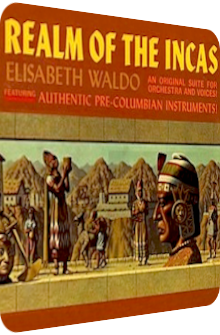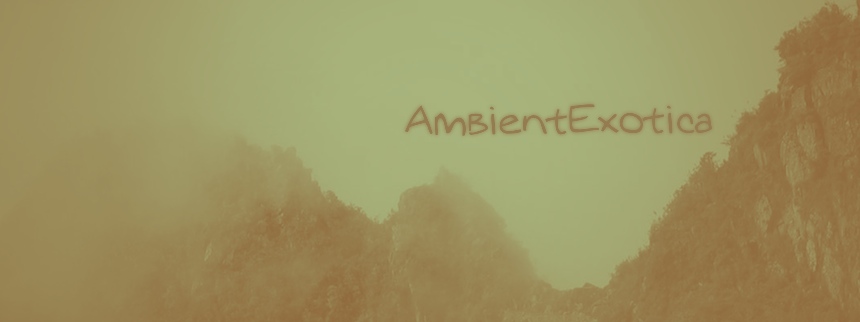
Elisabeth Waldo
Realm Of The Incas
1961
Realm Of The Incas is the follow-up to musical archaeologist Elisabeth Waldo’s most-impressive and realistic Rites Of The Pagan (1960), comprising of ten colorful tracks and released about a year later in 1961 on the GNP Crescendo label. The wideness has narrowed on this subsequent album, and indeed, one cannot like both works equally, even though the quality is top-notch and does not degrade in the slightest. However, not only is Realm Of The Incas more focused on one landmark and time frame, namely the Incan habitat of the 13th and 14th century respectively, it also features less amounts of researched exotic instruments.
Their variety does not match the overwhelmingly large pool of Rites Of The Pagan, but this has nothing to do with budgetary cuts rather than the fact that a wealth of Native instruments was used on that first album, whereas Realm Of The Incas is created via pre-Columbian instruments only, among them sonajas (clay rattles), silbatos (clay whistles), ocarinas, caracolitos (shell raspers), pan flutes and other devices. In addition, Elisabeth Waldo integrates a brass ensemble à la Hollywood to the ten sceneries. There is even a genuine aesthetic reason for their inclusion, one that unexpectedly hits the attentive listener near the end of the album, but more about this later. The orchestral, choir-underlined oomph is mostly used to stress the festive character and the majesty instead of dangerous situations or sinister incidents. Come to think of it: the latter leave room for interpretation, but again, this is unraveled over the course of this review as well. A few Ambient arrangements round the more joyous, festive and gleeful constructions off.
Land Of The Sun Kings undoubtedly has a majestic title and is a sun-dappled allusion, and it so happens that both connotations are united here. The opening seven-note droplets of the silbato (clay whistle) followed by an amicable Incan preacher is an enchanting anacrusis to this day, even in a cheekily remixed form as presented by the British electronic music duo Bent who use this very passage in their tune Exercise 3 off their album The Everlasting Blank (2003). It seems as if Elisabeth Waldo herself used electronic devices to alter the sound due to the falsetto shrapnel of the warbled flute, but this is certainly not the case. A pentatonic polyphony of stringed instruments suggests a short fleeting visit to Far Eastern climes all the while the maraca-like caracolitos are sizzling rhythmically. Hollywood brass fanfares and timpani link the present to this past. A duo between an Yma Sumac-like temptress and a chanter towers above the interstitial lacunae between each tone. The good-natured tone sequences and the rustic drums augment the feeling of a gleeful procession.
This great start is further ennobled by Song Of The Chasqui which relies on a much more stable rhythm and ameliorates it with ocarinas, plinking ceremonial flutes, echoey chants and various gongs. The entropy of the harmonies is again filled with revelatory feelings of bliss, a tramontane aura is evoked. The interplay of the segues is awe-inspiring, the melodies graceful and embracing. The opener Land Of The Sun Kings was designedly pompous, but Song Of The Chasqui narrows down the textural pool in a good way and offers a varied yet contingent mountainous listening experience. This composition could have been created by Moisés Vivanco indeed.
Incan Festival Dance is comparatively self-explanatory right from the get-go, but it is important for the Exotica connoisseur to look forward to a fruitful, cheerful dance rather than a fearsome, gloomy one. The signature elements of this arrangement are of the spiky and fizzling kinds. Firstly, the conical flutes reach ethereal regions and are enormously incisive, almost resembling phoenix-like coils which traverse the setting in serpentine ways, and secondly there is the Hollywood-esque solemnity of the brass instruments which encapsulates the Pagan ritual in a shard of controlled field-tested aesthetics. Sicily-like guitar spirals, chants and curiously pointillistic-mellow flutes draw from additional traditions all around of globe.
On The High Plateau then feels enormously lofty again as if a gaze onto the Andes was transformed into music. Cocoon rattles, croaking caracolitos, friendly flute helixes and careful double bass accents make this one of the more minimal and Ambient-like compositions, but its peacefulness is the biggest strength. The body of the multifaceted melody is augmented by each respective flute layer and hence creates that archetypical but ever-working feeling of being in high altitudes. A gorgeous, almost meditative take. Side A closes with Making Chicha, and whoever interprets this tune as specifically inebriated would be right, as it is about the brewing of an alcoholic beverage similar to beer. The mood is bucolic. The chants are loud, laughter and whistles fill the air, sanguine guitar placentas and droning drums round off the mirthful and histrionic episode.
Side B starts with a favorite of mine, the stupendous Balsa Boat with its aqueous riverbed in the form of water-filled buckets which ennoble the peaceful journey with their splashing physiognomy and another faux-Sicilian guitar romance. Clinging tambourines and a mixed choir carve out the sunset phase further. The layered flutes illumine the rather crepuscular but soothing setting. Balsa Boat is easy to describe, but any description lacks the magnitude, the wideness and implied landmarks of this journey. A delight despite of its murkier undertones and a great counterpoint to the album’s overarching theme of joy. Swinging The Quipu then depicts the art of disengaging and expounding the mystical device of several knots that were used to record statistical informations. For such a meaningful – and pre-bureaucratic task –, the feeling is particularly uplifting with the quick succession of handclaps and the effervescent flutes as well as the increasing tempo, but the dusky guitars and the distinct military march structure serve as acroamatic counterparts.
Saycusca! (The Wearing Stones) is another gorgeous Ambient tune. Its signature elements are the many fissured interstices for the shakers, rattles and humming choirs to fade out to. The short bursts of various textures and the whispering voices create a superbly friendly take of a nocturnal event. Everything is positively streamlined and utterly enchanting. While Dance Of The Nustas takes the same ambience and spices it with warbled flutes, short brass fanfares, handclaps, female choirs and stringed devices that are the literal calm before the storm, the finale Entrance Of Pizzaro breaks with the intrinsic mood and creates mountains of prowess and pride as conquistador Francisco Pizarro enters the sacred world of the Incas. The atmosphere is surprisingly celebratory, the most beautiful and euphonious flutes conflate with the Spanish marker to include, the castanets. The brass flourish reminds of Pizarro’s military power, but regardless of this looming motif, Entrance Of Pizarro ends in a hopeful way that is based on mutual understanding. What happens afterwards is not part of the album. In this regard, Elisabeth Waldo has kept this very paradise intact by neglecting the bellicose progression, as every good Exotica album tends to do.
Whereas 1960’s Rites Of The Pagan captured the aura of truism and historic facts, Elisabeth Waldo’s follow-up Realm Of The Incas is flowing in a decidedly freer and unperturbed form, allowing the musical archaeologist to draw from many ideas and let her inspiration shine more than ever. The Incan album is much keener on the feelings of joy and company. Furthermore, it also remains in one setting and time frame, namely that of the Incas. The instrumental base is therefore narrowed, but this makes the album a strongly cohesive and much more exotic album in hindsight, with less gimmicky complexions and usages of instruments just for the sake of using them. Elisabeth Waldo has an ear for melodies and the interdependencies of textures, and it transfers well into the uplifting pieces.
The second column is based on the aforementioned Ambient-like tunes which truly shine and spawn both a mystical aura and a soothing timbre; Balsa Boat and Dance Of The Nustas are the cream of the crop here, but even the mountainous Song Of The Chasqui and On The High Plateau contain mellow channels and evoke the breathtaking vista of the Andes. Realm Of The Incas can definitely be called an Exotica album with pride. It is a very special work of ten unique pieces that unite the sylphlike symphonic system with traces of Hollywood brass bursts and historically correct instruments. It is much more entertaining and less alienating and pompous than its predecessor, and it depends on the listener whether this is a tendency to be embraced or elbowed away. As luck has it, Realm Of The Incas has been reissued digitally and is also available on CD where it is coupled with Rites Of The Pagan. There are not many vintage Exotica albums of this very scope out there, so this time, it is not enough to merely know about Mrs. Waldo’s works… one has to encounter them.
Exotica Review 374: Elisabeth Waldo – Realm Of The Incas (1961). Originally published on Sep. 13, 2014 at AmbientExotica.com.
